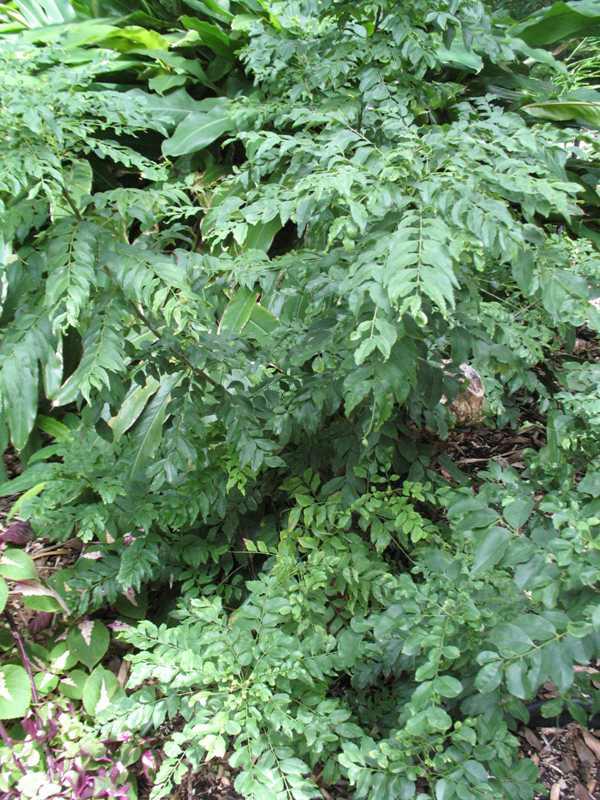Curry leaf (Murraya koenigii)
Curry leaf
Murraya koenigii, called curry leaf, is a small, tropical to sub-tropical tree or shrub that typically grows to 6-15′ tall and is noted for its pungent, aromatic, curry leaves which are an important flavoring used in Indian/Asian cuisine. This tree is native to moist forests in India and Sri Lanka. Each odd-pinnate leaf typically has 11 to 21, thin, ovate, shiny, dark green leaflets (1-2″ long). Fragrant white flowers (each to 5/16″ across) in many flowered panicles (terminal cymes) bloom irregularly throughout the year. Flowers are followed by 1-2 seeded, ovoid to oblong, bluish-black fruits (each to 2/3″ diameter). Fruits are edible but the seeds are not. Curry leaves are highly aromatic when rubbed or bruised. They are best used fresh in cooking (dried leaves may be used but have significantly diminished flavor). Aroma/flavor of the fresh leaves is enhanced when the leaves are fried in oil or butter. Curry leaves are often added to vegetable dishes. They add subtle flavors to many other dishes, including meat, seafood, chutneys, coconut sauces, relishes, marinades and omelets. Yellow curry powder (developed by the British during the time of their colonial rule in India) is a blend of many different Indian spices, one of which is sometimes (but not always) curry leaf. Curry plant (Helichrysum italicum) is a totally unrelated plant (an herbaceous annual of the Aster family) that has a curry-like aroma but is not recommended as a substitute for curry leaf in cooking.
Murraya paniculata is a host of the Asian citrus psyllid, which is a vector for the bacterium that causes citrus greening disease (Huanglongbing).
Genus name honors Johann Andreas Murray (1740-179- , Swedish pupil of Linnaeus and professor of medicine and botany, Gottingen.

Winter hardy to USDA Zones 10-12 where it may be grown in rich, moist, well-drained loams in full sun to part shade. Best sited in locations sheltered from strong winds. In St. Louis, plants may be grown in containers that are overwintered indoors. Place containers in bright light in east, south or west windows. Allow soil to dry between waterings. Propagate by seed or root suckers.
| Hardiness zone | 10 - 12 |
| Sun light | Full sun to part shade |
| Water | Medium |
| Maintenance | Low |
Watch for mealy bugs on indoor plants. Root rot may occur if soils are kept too damp.
Interesting house plant, the leaflets of which can be snipped for cooking.
| Common name | Curry leaf |
| Botanical name | Murraya koenigii |
| Plant type | Broadleaf evergreen |
| Family | Rutaceae |
| Hardiness zone | 10 - 12 |
| Water | Medium |
| Maintenance | Low |
| Flower color | White |
| Flowering period | Seasonal bloomer |
| Height | 6 - 15 ft. |
| Width | 4 - 12 ft. |